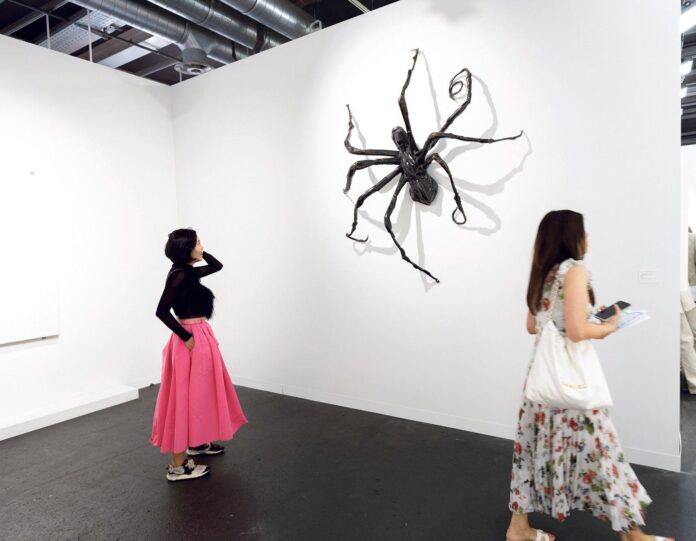Art Basel, described by its new chief executive Noah Horowitz as “the single most important annual event in the global art market” and the “barometer of the industry”, opened its doors to VIPs yesterday, with many remarking that the fair was the busiest they had seen in years. Security personnel at one crowded mega-gallery nervously herded clients past multi-million-dollar paintings as major collectors and curators, including Frank Cohen and Cecilia Alemani, were spotted strolling the aisles of the Messe Basel.
And, despite talk among the trade of a “cooler” market, clients were spending. Early seven- and eight-figure sales include Gerhard Richter’s oversized sculpture STRIP-TOWER (2023), presented by David Zwirner at Unlimited, for $2.5m. The most expensive work reported to have sold during the VIP preview was a 1996 Louise Bourgeois sculpture at Hauser & Wirth, which went for $22.5m to a US collector; the gallery also sold a painting by Philip Guston for $9.5m. Blue-chip work on the primary market that sold yesterday included a new painting by Jonas Wood, offered by David Kordansky Gallery for $2.5m.

Mark Rothko’s 1955 work, Untitled (Yellow, Orange, Yellow, Light Orange), remains on sale at Acquavella with a price tag of $60m David Owens
Pre-sales down?
Nonetheless, as the preview day neared its close, a number of big-ticket pieces had not been placed, including the most expensive: a sunset-hued $60m Rothko painting offered by Acquavella Galleries. Also without confirmed sales are a Picasso, for a reported $25m at Landau, and a $14m Joan Mitchell triptych at Pace.
“A lot of major works get sold on the second and third day, and that’s generally been the case for the past five years,” says Pace’s president, Samanthe Rubell, noting that the gallery kept pre-selling to a minimum this year. “We leave room for happy accidents to happen but make sure that our artists’ work gets into the most important collections.” Deals closed on the stand in the early hours of the fair included an Alexander Calder mobile for $2.8m and two smaller works by the artist, offered by his family, for $775,000 and $675,000.
Sadie Coles, whose London gallery sold “multiple” new works from a solo stand by Laura Owens, priced between $90,000 and $1.8m, says that she kept things “old school” and did not send out a preview list of works to her clients. On the other hand, Gagosian, for example, sent out a checklist numbering more than 100 pages to its clients. Andrew Fabricant, the gallery’s chief operating officer, says that the opening day was “the busiest in years”.
Talk of pre-sales is particularly germane following a New York spring auction season marked by reserved bidding, works bought in and lowered reserves. “Inflation, interest rates, politics and an ongoing war are all affecting consumer confidence, causing a slowdown of the art market,” says the art adviser Nilani Trent.

A Philip Guston painting, at Hauser & Wirth, was sold to a US collector for $9.5m David Owens
“My general sense is that the overall market is cooler,” says the dealer David Nolan, who is showing at the fair, continuing that “this is a necessary correction that is needed in the market every now and again”. Nonetheless, tricky times are often prime opportunities to buy art, with galleries more amenable to discounts and collectors looking to free up capital. “There is such diversity in the types of people who come to Basel, many of whom budget specifically to buy at Art Basel, and who are less affected by the stock market and the interest rate fluctuations,” Nolan adds.
Horowitz paints a more confident picture. “There’s been a lot of talk about whether there is a correction. Clearly, the balance of the auctions is indicative of a real reset. But, equally, demand for art is resoundingly strong,” he says. Regarding pre-selling, Horowitz thinks that there is less at the fair this year, suggesting that collectors are taking longer to commit. He concludes: “You have to work harder to get business done, but business is getting done—at pretty rich price points as well.”

























